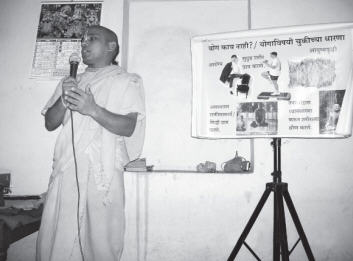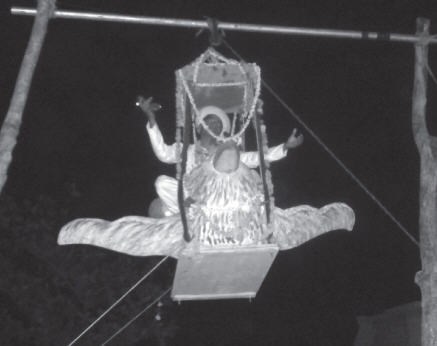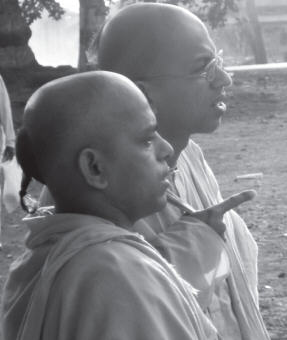
A Hare krisna devotee tries new and some old methods to take lord caitany's teachings to the vilages of his country.
Six year old Manjunatha bursts into the courtyard breathless,"Aai,Hare Krisna vale ale.Me challo tyenchya kade!"(Ma,the Hare Krsnas have arrived.I am going to them).Without waiting for his mother's reply,he pulls up his shorts and rushes out in the street,where a group of men dressed in dhoti and kurta are chanting Hare Krsna and blissfully dancing.Manjunath eagerly joins the dancing party and as the group passes in the streets of Ambiste,a nondescript village in Maharashtra,Manjunath calls out his friends,who too jump and join the sankirtana party.Ladies peek behind their veiled faces and smile to each other,men nod and clap their hands.The group moves on till they reach he festival sight the ground of the primary school.The rowd now swells up from fifty-sixty kids to more than two hundred elders.A short,stocky man in saffron robes,who had been leading the sankirtana so far,turns to them and smiles,"Welcome to the Hare Krsna festivall"
DIARY OF A TRAVELING PREACHER
"For a long time I dreamt of spreading Krsna consciousness in the villages of Maharashtra," says Rupa Raghunatha Dasa,the devotee behind the entire concept of the Hare rsna festival.Born in the country side,he grew up in the gurukula arratched to ISKCON Chowpatty."After I completed high school,I decided to dedicate my life completely to the mission of Srila Prabhupada and join the movement as a full -time devotee," he says.After an initial stint at Belgaum temple he joined ISKCON Chowpatty as the head pujari,a ervice he performed for more than ten years.Then one day,he was told to leave the altar and take up the leadership of the traveling sankirtana bus party.
"I was devastated," Rupa Raghunatha recalls."I was so attached to Deity worship that to even think of doing any thing else was heart-breaking.For days and days I sulked nd cried unwilling to leave.The temple leaders then took me to my spiritual master,His Holiness Radhanatha Swami Maharaja,who inspired me to spread the teachings of Lord Caitanya by actively preaching."
For the next three years,Rupa Raghunatha traveled the length and breadth of India distributing Srila Prabhupada's books and doing congregation al programs.Under his eadership the bus party was instrumental in distributing ore than 60,000 Back to Godh ead magazines in the Nasik Kumbh mela,2003.
"The days of sankirtana were very in spiring for me,"he reminisces."We were completely dependent on the mercy of the Lord.There were situations when we had no one to help and save us,but,some how by God's grace we were always protected."
But Rupa Raghunatha wanted to do more."ISKCON has an image of an urban organization with a membership restricted to the rich and educated,"he says."For amovement to actually e established in India it must have,amongst its recruits,members from the grass root levels-members from the countless villages who constitute more than 70% of the Indian population.But I saw no program that effectively cultivated these ruralmasses.Deep wthin me there was always a hankering to take the wonderful teachings of Lord Caitanya as given by Srlla Prabhupada to y rural countrymen.Lord Caitanya also predicted,'In every own and village My name will be chanted.' "
Still there was no strategy in sight.Then,one day,somebody gifted him A Diary of a Traveling Preacher-the traveling nd preaching accounts of famous ISKCON sannyasi His Holiness Indradyumna Swami.For hours and hours Rupa aghunatha immersed himself in reading and rereading the wonderful adventures and amazing stories of Indradyumna Swami as he traveled the length and breadth of the globe spreading Krsna consciousness in areas where no devotee had everset foot before.The diary gave Rupa Raghunatha the st rategy he was looking for."I noticed a pattern of preaching that was highly successful," he says. "The concept of olding a colorful festival with harinama, prasadam istribution,dramas,and cultural activities cut across any man-made boundaries and universally attract ed audiences from diverse backgrounds.Soon a similar concept began to evolve in my mind."
Then came another break.After a three year stint with the bus party Rupa Raghunatha got the much wanted freedom to explore preaching in the villages. He was asked to head the village preaching in the villages around the temple's newly acquired farm.Delighted Rupa Raghunatha readily accepted.He was ably supported by Sanat Kumara Dasa,one of the temple presidents and head of the farm project.
RUSTIC STYLE
Preaching in the villages has its own challenges.While a reacher in a metropolis such as Mumbai uses computers and ffers multi-media presentations in air-conditioned halls to a sophisticated intellectual crowd,a village preacher will be faced by half-naked dirty kids,shy women,simple hard working peasants and illiterate aborigines.Roads are rarely maintained and power supply is scarce.

Rupa Raghunatha rose to the challenge with his own improvised preaching tools."I realized that to fulfill my dream I would need a team of dedicated devotees.Since I had none I had to create some.I began by visiting villages on oxcarts,carrying a portable battery charged sound system and buckets full of prasadam.We would do kritana in the village and when a sufficient crowd gathered we would give a short speech and then distribute prasadam'Over a period of time some youngsters came forward to ask questions and gradually I began a weekly program in two to three villages.A core group developed."
Another of his improvisations was a mobile display of Krsna consc ious flex slides.He saw a highly successful introductory Bhagavadgita course that gave the basic teachings of Bhagavad-gita,ike laws of karma,reincarnation,etc.,to newcomers.The challenge was to replicate the slick presentation to the Vilagers.Rupa Raghunath translated the contents of the slides into Marathi,and made beautiful slides and printed them on X3 feet flex sheets.Then he got a camera stand and got a lex stand tailormade for it.Everything could be neatly packed in a shoulder bag. He traveled with this bag to vari0us village programs and presented the six session course in open grounds.
After a core group developed,he decided to implement is dream of Hare Krsna festivals.
MAKING OF THE FESTIVAL
"The idea was to present Krsna consciousness as a cultural event identical to the teachings of great Maharashtrian Vaisnava saints like Tukarama Maharaja." Srila Prabhupada writes about Saint Tukarama in his introduction of Srimad-Bhagavatam Canto 1:"The great saint of Maharashtra known as Saint Tukarama was also initiated by the Lord (Caitanya).Saint Tukarama,after initiation by the Lord,over flooded the whole of the Maharashtra Province with the sankrtana movement …,"
A few devotees help in publicity, erecting the pandal,printing banners and pamphlets announcing the dates and timings of the festivals.A few days before the festivals,devotees take a palanquin of Gaura-Nitai Deities into the village accompanied by harinama sankirtana.The harinama party goes to different streets in the village.Villagers come out of their houses with arati plates and bhoga to offer to the Lordships.Everyone competes to render service to the Lord,so much so that to cross a single lane sometimes takes two to three hours.Finally it is decided to have a ollective arati at the end of the lane for the all the residents.All this prepares the villagers for a bright festival day ahead.
THE DAY OF THE FESTIVAL
We go back to Ambiste,and join Manjunath and his young friends.Everyone had been eagerly waiting the festival- it's a festival of the entire village.Villagers are in their best clothes: men with bright turbans and women dressed in colorful saris join the harinama procession to the pandal.The mud path leading to the pandalis swept clean and sprayed with water to prevent dust from rising.up from crowd's walking.Ladies have drawn beautiful patterns and designs with rice powder mixed with colors in front of their houses.There is a welcome gate on the pandal,erected with flags and auspicious banana stems and leaves.

After an ecstatic kirtana and welcome speech the devotee childeren from the gurukula perform an inspiring drama of he life of Saint Tukrama.The crowd watches spell-bound as little childeren put up asterling performance.(The youngsters have spent hours watching a movie on the life of Sain tTukarama and practiced for days for this show).The 45 minute long drama describes vividly his faith in Lord itthala (Krsna),his turbulent marital life,his persecution by the smarta-brahmanas,and how eventually he is able to lead the masses in chanting of the holy names of the Lord.In the fina l scene,Saint Tukarama goes back to the spiritual world in the self same body.For this scene,the devotees have made aspecial wooden Garuda-vimana on which the boy playing the role of Tukarama Maharaja sits and ascends to the spiritual world.As the boy sings,"Ami jato amcha gawa"(I am going back to my home),the vimana slowly ascends up,being pulled by ropes attached to a pulley above.People are so moved that many openly wipe tears from their eyes.A man,who is a director of karmi plays,tells the residents,"That boy (Saint Tukarama) acted so nicely,that even if you bring any hero or superstar,he cannot imitatet he expression of that little boy!"The play remained the talk of the village for many days to come.
Then Rupa Raghunath gives ashort talk on basic Krsna conscious philosophy.People become so mesme rized by the performance and their hearts are so much softened that they readily accept the message.then there is a final kirtana and prasadam for all.The festival is followed by a four-day ntroductory Gita course followed by an exam.All the participants receive a completion certificat e and are invited for a higher course which later expands into a regular preaching program.
Help comes from all quarters.Villagers donate in all kind,from rice,dahl,ghee,and vegetables to simple voluntary service.Varah a Rupa Dasa,a cook from Belgaum,volunteered to cook the entire feast for all the festivals.Congregation members donate money,stationery and gifts for the articipants.Other devotees come to participate in kritana,book and prasadam distribution,publicity,and question-a nswer both.
The villagers remember the day as a spiritual festival never seen before."The kind of kritana that you played is still ringing in my ears,"a villager later tells the devotees.Hit is so memorial,so jubilant to simply chant the holy names of the Lord and dance with no worry."
For Rupa Raghunath the path is clearly etched.With thirty-six districts in Maharashtra and ten to twelve tehsils in each district,and countless villages in each of them, even if he spends one day in each village,he will be occupied for years.And then he can repeat!
"My desire is not to make devotees straightaway,"he says,"but to make friends of Lord Krsna,to create awareness about Krsna consciousness, to give this holy name of Lord Krsna.Through the holy name we started and it is the best advertisement.It keeps me inspired."
